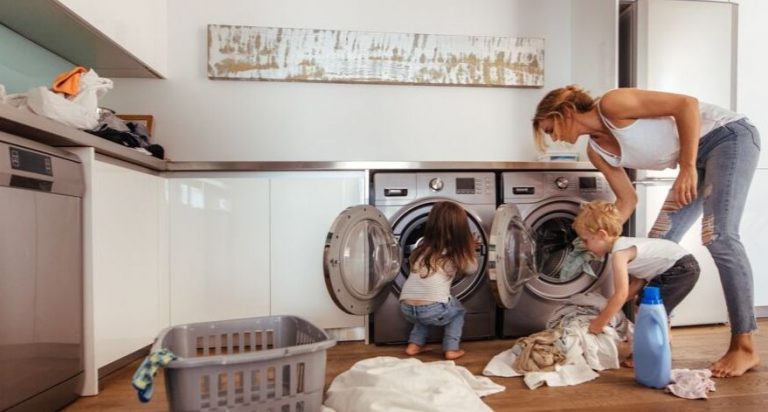Keeping Your Clothes and Washing Machine Clean
How to Clean Your Washing Machine
The dreaded pile of laundry is something that plagues every home. With clothes, towels and linen in need of regular laundering, most people give daily thanks for the washing machine.
Your washing machine looks after you, but do you look after it? For it to function at optimal levels, you need to keep it clean. A dirty washing machine will not clean your laundry. Instead, your washing will be exposed to germs, bacteria and mold that may be harmful to you and your family. That is why you must keep your washing machine clean.
Cleaning a Front-loading Washing Machine
A front-loading washing machine is an ideal choice for people whose laundry room offers under counter facilities. It has an airtight seal around the door to prevent the leakage of water. Very often during the cycle, the water lies in the rubber around the front door.
The door seal can quickly start showing signs of mold. Cleaning it is not always easy since you do not want to damage the seal in the process. It is better to do preventative cleaning on a monthly basis.
To clean your front-loading washing machine, you need two cups of vinegar and a quarter cup of baking soda. Set the machine to its longest, hottest cycle. Add the vinegar and baking soda and then allow the machine to run through the full cycle.
When it is complete, examine the door seal. You can clean away any signs of mold with a vinegar and baking powder mix using an old toothbrush to reach right inside.
Wipe the interior and exterior surfaces with a dampened sponge or cloth. Dry them with a clean cloth. Repeat this process every month.
Cleaning a Top-loading Washing Machine
As the name implies, the aperture of this type of washing machine is at the top of the machine. These machines tend to hold more laundry than their front-loading counterparts. While a top-loading machine might have a larger capacity, cleaning it is a bit more complicated.
Put four cups of bleach into the washing machine. Set it to its longest, hottest setting. Allow the drum to fill completely. Stop the machine and let it soak for a full hour. Start it again and allow the cycle to finish.
You will need to follow the same process again, with two variations. First, replace the bleach with four cups of vinegar. Second, once the machine has stood soaking for an hour, dip a sponge in the vinegar water and clean the machine’s surfaces. Use an old toothbrush for hard to reach areas. Then allow the machine to run the remainder of the cycle.
Once the machine has stopped, dry the interior surfaces with a cloth. The process should be repeated monthly.
Cleaning the Washing Machine Drum
A washing machine drum is a place that bacteria would call home sweet home. It is warm and damp. Best of all, it is dark since most people close the washing machine, opening when it is not in use. This trifecta of conditions makes your machine a magnet for germs. They get into your laundry and can be the cause of illnesses. Together with mold, they can cause your machine to be smelly when you open it.
This is the reason why cleaning a washing machine requires you to use its hottest setting since heat kills germs. The cleaning agents you use in the machine make it easier to clean up patches where germs and mold may be breeding. Drying the drum afterward leaves no dampness behind in the drum.
To avoid problems with the drum of your machine, here are some steps you can follow each time you use your machine. Dry the drum out with a cloth when you are finished doing your laundry. After using the machine, leave the door open for a couple of hours, preferably in some good light. Germs do not like fresh air and light.
Cleaning the Washing Machine Drain
Remnants of laundry detergent and softener may linger in your washing machine’s drain. The buildup of soap scum can prevent your washing machine’s drainage pipe from working efficiently. The pipe becomes clogged and you will notice that it is draining very slowly. The pipe system the hose drains into can also become narrowed similarly.
As a rule, the very hot water generated when you run the machine on its hottest cycle to clean it will unclog any piping. However, if it does not, you will need to perform some extra steps. First, you will need to remove your drainage hose from the machine. This can be a little messy. Have a towel handy as some water will continue to come out of the machine after you have removed the pipe.
Use a plumbing snake to clean the hose. As the snake travels through the pipe, you will be able to detect areas of resistance. These clogs will be forced down the length of the pipe by the snake. You can then get them out of the pipe. After that, just running the machine on its hottest setting should do the rest of the job.
While the hose is off the machine, clean the area where it fits into the machine. It is also susceptible to the buildup of mold as there is often water standing in it.
Cleaning the Washing Machine Filter
Your washing machine’s filter catches lint and other pieces of dirt as the machine drains. The filter is easily clogged, which can affect your machine’s drainage.
Follow the directions in your washing machine’s manual on removing the filter. Clean away any fluff with a dry paper towel. Take the filter screen out and soak it in very hot water for 5 to 10 minutes. Clean it again with a cloth. Do not use abrasive cleaning tools like scrubbing brushes as they can damage the filter screen.
Put the filter screen back into its housing and put it back into the machine. Make sure it is securely fitted according to the directions. Run the machine while empty on a regular cycle to make sure that it is not leaking.

